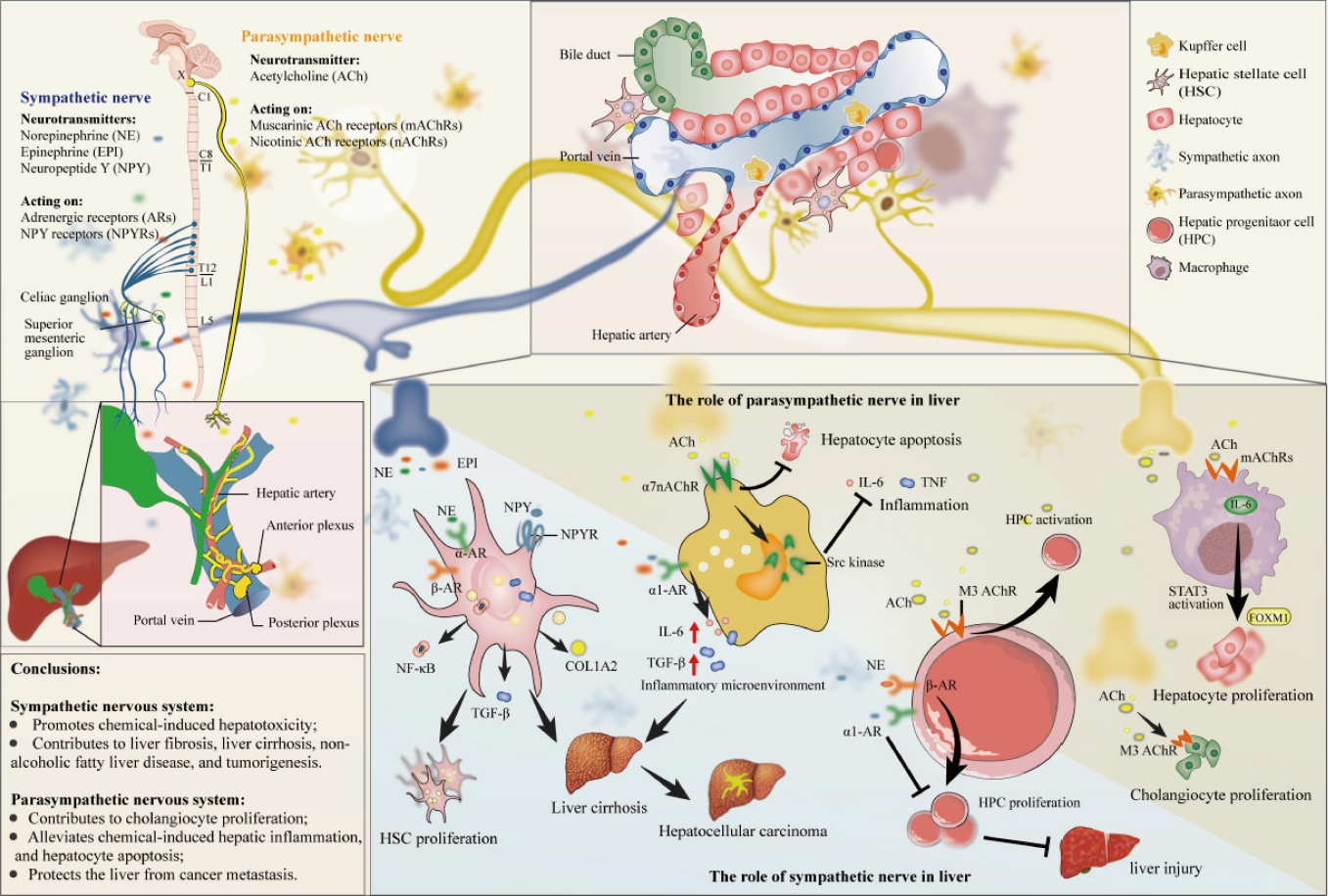The role of the hepatic autonomic nervous system
Article information
The regulation of liver function and homeostasis are wellknown to be controlled by both the sympathetic and parasympathetic nervous systems. Growing research has emphasized the significance of the autonomic nervous system in liver diseases [1]. However, the mechanisms underlying these processes are still not fully understood.
Preganglionic sympathetic innervation of the liver originates from the T7–T12 thoracic nerves, while the postganglionic sympathetic innervation from visceral nerves originates from the celiac and superior mesenteric ganglia. Parasympathetic innervation (vagus nerve) stems from the medulla oblongata. The anterior plexus forms a sheath around the hepatic artery and enters the liver via the hepatic artery. The posterior plexus is predominantly distributed along the extrahepatic bile ducts and portal vein, with branches communicating with those from the anterior plexus. The neural plexuses in the liver closely interact with liver sinusoidal cells, hepatic stellate cells (HSCs), Kupffer cells (KCs), and hepatic progenitor cells (HPC). In various models of chemical liver injury, the sympathetic nervous system (SNS) contributes to liver inflammation, injury, and fibrosis [1]. Conversely, vagal nerve signals promote liver regeneration by inhibiting apoptosis and exhibiting anti-inflammatory effects [2].
SYMPATHETIC NERVOUS SYSTEM
The SNS contributes to the development of non-alcoholic fatty liver disease and hepatocellular carcinoma (Table 1). In liver injury models, increased expression of alpha and beta-adrenergic receptors (α/β-AR) and neuropeptide Y (NPY) receptors on HSCs promotes liver fibrosis and cirrhosis by inducing HSCs proliferation and secretion of inflammatory factors. Epinephrine (EPI) and norepinephrine (NE) induce the production of collagen-1α2 (COL1A2), transforming growth factor-beta (TGF-β), and induce the activation of NF-κB by acting on HSCs [1,3]. Moreover, the SNS promotes liver inflammatory microenvironment formation and hepatocellular carcinoma development by regulation of interleukin (IL)-6 and TGF-β through activation of α1-AR on KCs [4]. Soeda et al. [5] showed that the SNS inhibits HPC and promotes liver injury by activating α1-AR. However, β-AR agonist isoproterenol-mediated β-AR activation rescues acetaminophen (APAP)-induced liver injury by promoting HPC proliferation through Wnt signaling activation.
PARASYMPATHETIC NERVOUS SYSTEM (PNS)
In contrast to the SNS, vagal signaling exerts protective effects on hepatic damage (Table 1). In a mouse model, the cholinesterase inhibitor neostigmine reduced APAP-induced acute liver failure and improved the survival rate of the mice [6]. The α7 nicotinic acetylcholine receptor (α7AChR) agonist exhibits an anti-apoptotic effect on Fas-induced hepatitis by suppressing KC-generated reactive oxygen species [2]. Moreover, parasympathetic nerve-secreted acetylcholine (Ach) inhibits expression of tumor necrosis factor (TNF) and IL-6 through activation of Src kinase by acting on the α7AChR of KCs, thus suppressing lipopolysaccharide-induced hepatitis [7].
Muscarinic acetylcholine receptor type 3 (M3 AChR) is proven to be expressed on the surfaces of cholangiocytes and HPC. Activation of M3 AChR plays an important role in cholangiocyte and HPC proliferation, anti-apoptosis, and liver regeneration [1]. Furthermore, PNS activation increases the expression of IL-6 in macrophages by acting on muscarinic Ach receptors (mAChRs). Furthermore, IL-6 promotes hepatic FoxM1 activation that stimulates hepatocyte proliferation through signal transducers and activators of transcription 3 [8]. Therefore, parasympathetic signaling may be a potential therapeutic target for patients with liver injury, hepatitis, and hepatic tumors.
However, studies showed that NE promoted hepatocellular carcinoma metastasis through α1/β2-AR activation, while the vagus nerve had a suppressive role in liver metastasis in mice [2,9]. Moreover, In a mouse model of Fas-induced fulminant hepatitis, the release of NE by the SNS demonstrates an anti-apoptotic and hepatoprotective effect by up-regulating the expression of IL-6 [10]. Notably, these studies were carried out in animal models, and many of these studies employed systemic administration of chemical sympathectomy, which does not selectively affect the liver. Therefore, further investigation is needed to clarify the role of the autonomic nervous system in liver.
Notes
Authors’ contribution
Q. L., P. L. Y. D., and T. Q.: conceptualization, writing, and figure design.
Conflicts of Interest
The authors have no conflicts to disclose.
Acknowledgements
This work was supported by the National Natural Science Foundation of China (31671440).
Abbreviations
HSCs
hepatic stellate cells
KCs
Kupffer cells
HPC
hepatic progenitor cells
SNS
sympathetic nervous system
α/β-AR
alpha and beta-adrenergic receptors
NPY
neuropeptide Y
EPI
epinephrine
NE
norepinephrine
COL1A2
collagen-1α2
TGF-β
transforming growth factor-beta
IL
interleukin
APAP
acetaminophen
PNS
parasympathetic nervous system
α7AChR
α7 nicotinic acetylcholine receptor
TNF
tumor necrosis factor
M3 AChR
muscarinic acetylcholine receptor type 3
mAChRs
muscarinic Ach receptors


